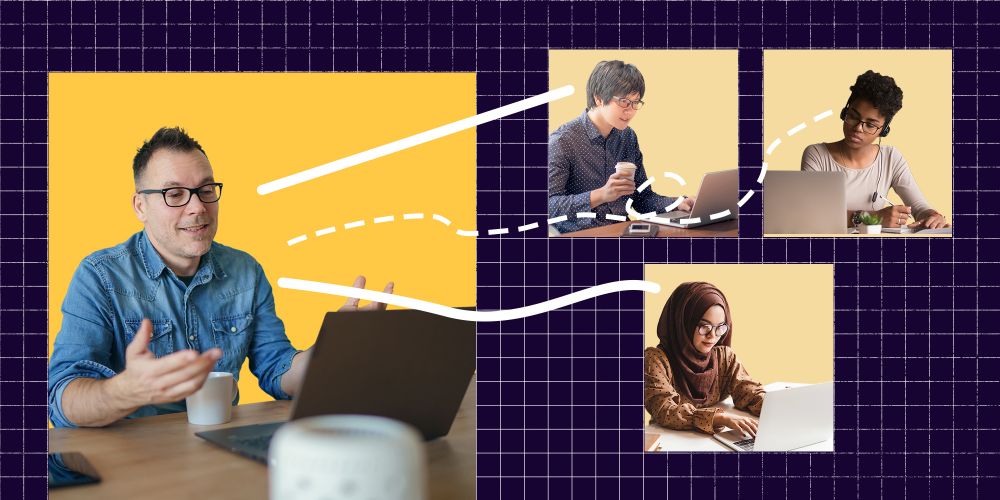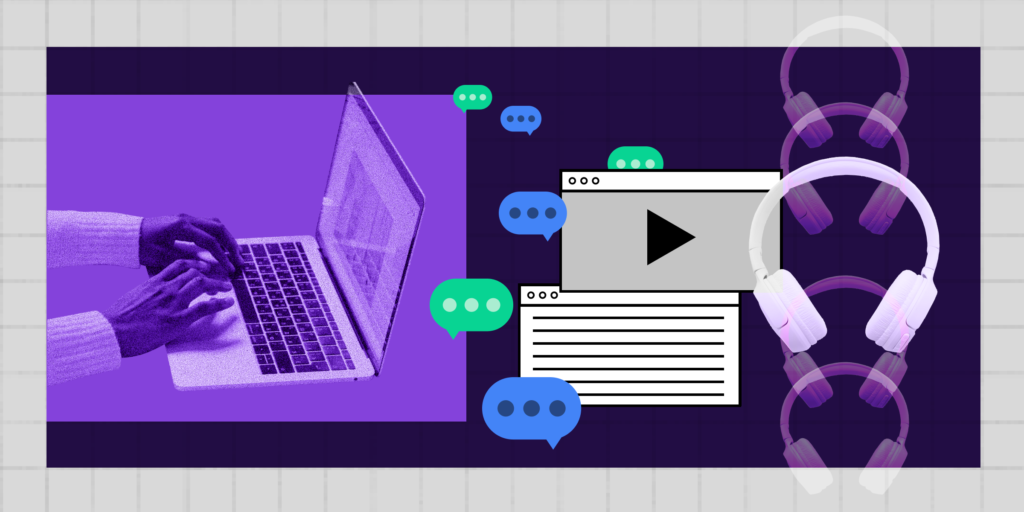In adapting to the ‘new normal’ of digital classrooms during COVID-19, the initial focus was simply moving the curriculum entirely online. But now educators are looking at ways to adapt their lesson plans to this new paradigm to make class time more engaging—and more effective.
Educators are well aware that students learn in different ways and at different paces. But the idea of providing a personalized learning experience for students in a digital classroom may seem like a daunting, if not impossible, task for educators thrown into the deep end of the digital realm. But this environment is, in fact, well suited to engage different types of learners through personalization—and it doesn’t necessarily require a big technical learning curve.
While taking a more personal approach might look a bit different online than it does in a traditional classroom, there are ways to adapt teaching methods and approaches for the online world to meet students’ needs, from introverts to extroverts. An added bonus? It will capture their attention and keep them from tuning out or drifting off during online classes.
What is Differentiated Instruction?
In a traditional classroom, teaching often followed a one-size-fits-all approach. Some students thrived, while others struggled. Instructors would make adjustments on the fly if it became apparent a lesson wasn’t quite working.
Differentiated instruction, also known as differentiated learning, is a teaching philosophy that considers the needs of all students, even if they’re in the same (virtual) classroom. This means teaching materials, assignments and assessments take into account diverse learning styles, as well as other factors such as gender, culture, ethnicity, socioeconomic status and personal interests.
“At its most basic level, differentiating instruction means ‘shaking up’ what goes on in the classroom so that students have multiple options for taking in information, making sense of ideas, and expressing what they learn,” according to Carol Ann Tomlinson, chair of educational leadership, foundations and policy at the University of Virginia—who is widely considered one of the most reputable thought leaders on this topic.
“In other words, a differentiated classroom provides different avenues to acquiring content, to processing or making sense of ideas, and to developing products so that each student can learn effectively,” she says.
But it’s important to distinguish differentiated learning from individualized instruction. While it’s still based on individual needs, differentiation doesn’t mean you have to come up with a customized lesson plan for each individual student—which would be exhausting and probably unsustainable.
Instead, while differentiation “advocates attending to students as individuals, it does not assume a separate assignment for each learner,” says Tomlinson. Nor is it chaotic; rather, what she refers to as “orderly flexibility” is a defining feature of differentiation, where student behaviour is more focused and productive.
Some key benefits to this approach include boosting student engagement and enhancing their motivation to learn, while also allowing them to take more responsibility for their learning. This can benefit a range of students, from high achievers to those with learning disabilities and everyone in between. For example, students who receive average grades might thrive in an environment where they can adapt learning to their preferences and interests.
Some instructors may worry that planning lessons with differentiated instruction will be a time-consuming task, especially if they’re in the midst of adapting to a digital classroom (and an uncertain future) during a global pandemic. Their worries are not unfounded. Admittedly, this approach will likely require more prep work.
Yet, differentiation lends itself well to the online world. As you attempt to make classes more interactive and engaging to students, you can integrate personalization through class activities and by using online learning tools.
To understand how to apply this approach in your online classroom, it’s important to understand the key pillars of differentiation: content, process, product and learning environment.
Key Pillars of Lesson Design for Differentiated Instruction
Content: This involves using diverse materials and teaching methods in class to cover course content. Some students may be somewhat familiar with the concepts in a lesson, while others may be unfamiliar; some may even show signs of early mastery. Differentiating content means using different materials and teaching methods to help students at all levels of comprehension, without lowering performance standards. In other words, the content remains consistent, but how students access content could be differentiated.
Processes: This relates to learning activities that help students master course content. It could include tiered assignments where different learners are offered different levels of challenge or complexity, or it could involve varying the time it takes different students to complete a task. In addition to assigned readings, you could offer the option of listening to a podcast or watching a video—or varying individual study with group work—to appeal to a variety of learning styles.
Products: This refers to ‘products’ such as tests, reports, projects and assignments where students demonstrate their mastery of content based on their learning preferences. For some students, demonstrating knowledge isn’t best achieved by a 10-page report. Students could be provided with a choice of assignments such as creating a video, writing a blog post, developing a podcast or building a 3-D object. It could, of course, also involve writing a 10-page report, because some students will prefer this method.
How Differentiated Instruction Works Online
A fourth aspect of differentiation is related to the learning environment itself—creating conditions for optimal learning in the classroom. This could include anything from the physical layout of the classroom to the overall atmosphere. But how does this work in a digital classroom?
The same general principles for physical classrooms can be applied online. Using a professional-looking space with good lighting for video lectures, offering small-group virtual breakout rooms, student-led chat forums and virtual office hours can go a long way in creating a comfortable virtual space for students.
A lesson will likely resonate with a wider swath of students if it targets visual, auditory, tactile and kinesthetic senses. This means applying several different teaching approaches in your lessons, such as watching videos, listening to audio clips, playing educational games and dividing students into pairs or groups in virtual breakout rooms, as well as providing both spoken and written directions.
You can also use tools such as online questionnaires, quizzes and polls to pinpoint what content will best meet students’ needs—asking them about their favourite class activities, for example, or about which types of exercises help them remember key points.
Differentiated Instruction Strategies for Digital Classrooms
For some students, giving an online presentation in front of their classmates is a terrifying prospect. Others will be in their element. That’s why differentiation blends individual, small-group, large-group and whole-class instruction across content, processes and products. It also takes into account learner readiness, learning profiles and learning interests.
There’s still room for traditional lectures (albeit in video form) and online class discussions, particularly when covering basic course material. But differentiated instruction can be applied to your digital classroom in ways that will engage students, while helping them meet the objectives of the course.
In unpacking differentiated instruction, it’s helpful to understand what it is—and what it isn’t. Differentiation doesn’t mean that ‘advanced’ students can skip their homework, or that ‘advanced’ students should be paired with ‘struggling’ students. But it could mean grouping students around their strengths and weaknesses so they can all learn from one another.
It’s also a good idea to avoid distinguishing students based on their pace of learning. “A fast-paced student might have only a superficial understanding of a concept, while a slower-paced student might have greater facility with the same concept and a greater ability to apply that knowledge or skill. In this case, the faster-paced student might have a lot to learn from the slower-paced student,” according to Steven Mintz, executive director of the Institute for Transformational Learning at The University of Texas at Austin, in an article for Inside Higher Ed.
Here’s how to differentiate instruction to meet a variety of student needs—even in the digital classroom:
Tiered assignments: Assign groups of students to specific tasks according to comprehension—they meet the same learning goals, but at different levels of challenge and complexity. Students can be grouped according to challenge level (where different groups tackle different assignments) or complexity (where different groups tackle the same assignment at a different complexity level).
Group work based on learning styles: After teaching a lesson, break students into small groups using virtual breakout rooms. Students can be grouped based on their learning styles (such as visual or auditory), rather than ability. Of course, not all students are aware of their learning style—and they may have more than one learning style—so a pre-assessment quiz can help determine how to group students.
Flexible groupings: This approach to group work allows students to rotate in and out of temporary groupings (whether pairs or small groups) to complement their own learning style. This does, however, require some pre-planning. Looking over student learning profiles will help create groups and ensure students rotate in and out of the most appropriate groupings.
Layered curriculum: This offers students a choice of assignments, though they’re still required to demonstrate mastery of course material in order to pass. It’s a good choice for instructors who are teaching a large online class but still want to provide differentiation.
Independent projects: Ask students to come up with their own project ideas and pitch them to you. The project must still meet academic standards, so students should be open to your revisions or refinements.
Student response systems: These systems allow for real-time collaboration, helping educators better gauge student understanding in order to differentiate instruction. You can create online quizzes, for example, that automatically assign differentiated follow-up activities or assignments based on the student’s score (and comprehension of material).
Game-based learning: Educational games can be used across a range of subjects. Look for platforms that allow you to monitor students, perhaps even generate reports, to assess learning and where any gaps exist. They can also promote self-paced learning; some games will adjust according to ‘player’ needs.
Interactive discussions: Rather than being the sage on stage—which is difficult in a virtual classroom, even for the most riveting of lecturers—use digital tools to facilitate interactive online roundtables, discussions and debates.
Hands-on activities: At first this may seem difficult to conduct in an online environment, but it could inspire surprising creativity in your students as they look for household objects to use in artistic or scientific projects. And it will appeal to students who are tactile or kinesthetic learners.
The Role of Assessment in Differentiated Instruction
The content, processes and products you choose to incorporate in your lesson plans should be based on data from student assessments (and related tools). Just as no two students are alike, no two classes are alike, so instructional activities should be flexible, based on the needs of both the students and the class as a whole.
“In a differentiated classroom, assessment is no longer predominantly something that happens at the end of a unit to determine ‘who got it.’ Diagnostic pre-assessment routinely takes place as a unit begins, to shed light on individuals’ particular needs and interests in relation to the unit’s goals,” says Tomlinson.
Throughout the unit, the instructor assesses students’ developing readiness levels, interests and approaches to learning, she says, and then designs learning experiences based on the latest understanding of students’ learning needs.
Pre-assessment: For differentiation to be effective, you’ll need to determine students’ understanding prior to a unit of study. Pre-assessment should be informal, providing qualitative feedback to identify learning preferences and interests, as well as student knowledge, strengths and areas of weakness. This can be done through online checklists, quizzes, self-reflection exercises and other types of pre-assessment tools.
Ongoing assessments: It’s important to continually assess and adjust content on a regular basis to meet evolving student needs. Formative assessments—such as assignments, quizzes and tests—can help to inform your instructional strategies. But they can also help you learn about students’ learning preferences so you can tweak and adjust your strategies accordingly.
Aptitude testing: Evaluate comprehension in ways that test different aptitudes—not just written answers (although that will still appeal to some students). Artistic or kinesthetic options can help some students demonstrate their understanding of content in a different way, such as delivering a presentation, performing a monologue or creating visual art.
When it comes to differentiated instruction, it’s important to recognize that “instructors aren’t simply content area specialists or evaluators of student work, but, rather, designers of educational experiences,” according to Mintz.
There’s a lot to learn in this new paradigm of online instruction. But as we move toward more personalization in the classroom, differentiation will help to meet the needs of all learners—even in the digital realm.


